A 6-Step Guide to Move From Freelancing to a Business in 2024
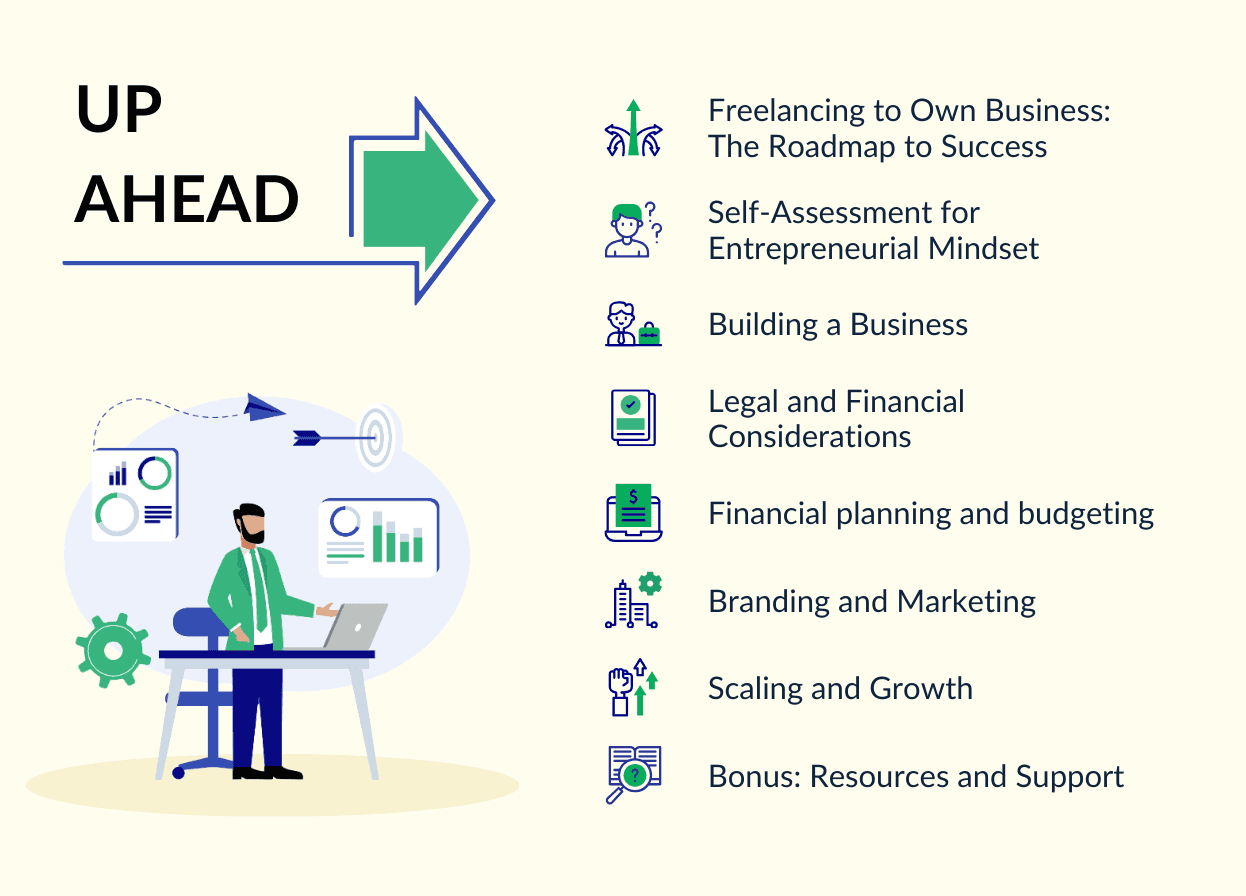

You feel stuck in your 9-5 job and start freelancing on the side to pursue your interests and earn extra income. Soon, freelancing offers more financial stability than the regular 9-5 job. However, a few months into full-time freelancing you feel that the gig scene has stagnated and you crave growth. The entrepreneurial mindset kicks in and you plan to set up a business.
Is it the right choice? What are the key components of a business plan? How to set up a business? How much finances do you need? These are some of the most common questions you might be struggling with.
To help you kickstart your journey, the blog explains the step-by-step process of transitioning from freelancer to business owner.
Freelancing to Own Business: The Roadmap to Success
There is no definite path to transition from a freelancer to a successful business owner because every professional has a different journey and freelancing experience. However, here are a few key components of a business plan that reduce friction and can help you grow your business.
#1: Self-Assessment for Entrepreneurial Mindset
Before you set up a business, perform a SWOT analysis to identify strengths, weaknesses, opportunities and threats. You can also consider the following factors.
- Core competencies
Identify your technical, soft, and industry-specific skills and compare them with the skills needed to grow a business.
- Assessing your freelancing experience
Reflect on your freelancing career and list experiences or learning that can help you grow from a freelancer to a business owner. For example, freelancing teaches business development, marketing, and sales strategy.
- Grow your entrepreneurial mindset
As a freelancer, you depend solely on yourself to make money. However, when you build a business, you need to set up processes and systems to get the work done without being directly involved in all activities.
It requires switching from a specialist to a generalist mode and overseeing sales, business acquisition, client relationships, and other functions instead of focusing solely on project delivery.
Being an entrepreneur means building a long-term strategy. It involves gaining excellent leadership skills, improving risk tolerance ability, and strategic vision and goal setting.
#2: Building a Business
Here is a step-by-step process for establishing your business:
1. Market analysis
In-depth market analysis is the key to establishing a successful business. It helps understand customer needs, identify growth potential in the market and conduct risk assessment. It includes the following elements:
- Identifying target market/audience
- Researching your competitors and their offerings
- Analyse customer behaviour and other preferences
- Research pricing structure in the industry and competitor pricing strategies
2. Understand industry gaps
Identify market gaps by researching the common pain points of customers in the particular industry. This involves researching emerging business and technological trends through target market analysis. It helps in product differentiation, enabling businesses to gain a competitive advantage. Here is how you can do it:
- Connect with your target audience and professionals in your network to understand industry trends and gaps.
- Conduct interviews, listen to podcasts and read authentic blogs and industry-specific reports to understand the major industry gaps.
3. Create a business plan
The key components of a business plan include all the elements you need to build the business, such as defining the value proposition, growth strategy, and marketing and sales strategy.
It provides a complete roadmap for the business, including contingency planning. Therefore, it reduces the risk of failure. A business plan should include:
- Business idea, mission and vision and its core values
- Target audience and competitive analysis
- Organisational structure and responsibilities of core management
- Business offerings and unique selling point
- Financial planning for at least the next three years
- Business growth timeline
- Risk analysis
- Marketing and sales strategy
4. Build a strong online presence
Growing a business means creating brand awareness and gaining credibility to attract customers. Therefore, you need to build an online presence. Here are a few strategies to implement.
- Build a website
- Engage with the target audience on social media by posting valuable content
- Use SEO to improve website traffic
- Share customer testimonials on social media platforms and website
5. Set up operational and financial processes
You also need to set up financial and operational processes for the smooth functioning of the business. Here is how you can do it:
- Allocate budget for various functions
- Integrate accounting software for bookkeeping and financial reporting
- Identify workflows and establish Standard Operating Procedures (SOPs) for various tasks, including quality control and customer service
- Implement tools to automate tasks and improve efficiency
Learn more: 8 Key Elements for Launching Your Tech Export Business Today
#3: Legal and Financial Considerations
Choosing a legal structure
Evolving from a freelancer to a business owner role may seem daunting at first because of the financial and legal aspects. You do not want to get caught in the whirlwind of compliance early on. Hence, it is critical to choose a suitable business structure.
Read here to learn about sole proprietorship vs. LLC vs. corporation, their advantages and the appropriate business structure.
Registering your business
Once you have chosen the suitable structure, the next step is to seek professional help and register your business. Business registration offers the following advantages.
- Reduces personal liability
- Enables you to avail of tax benefits
- Boosts credibility and gives better brand recognition
- Helps seek funding
#4: Financial planning and budgeting
Managing finances is the most crucial part that most freelancers struggle with while evolving from freelancer to business owner.
1. Startup costs
The following are some costs you need to consider from an entrepreneurial mindset
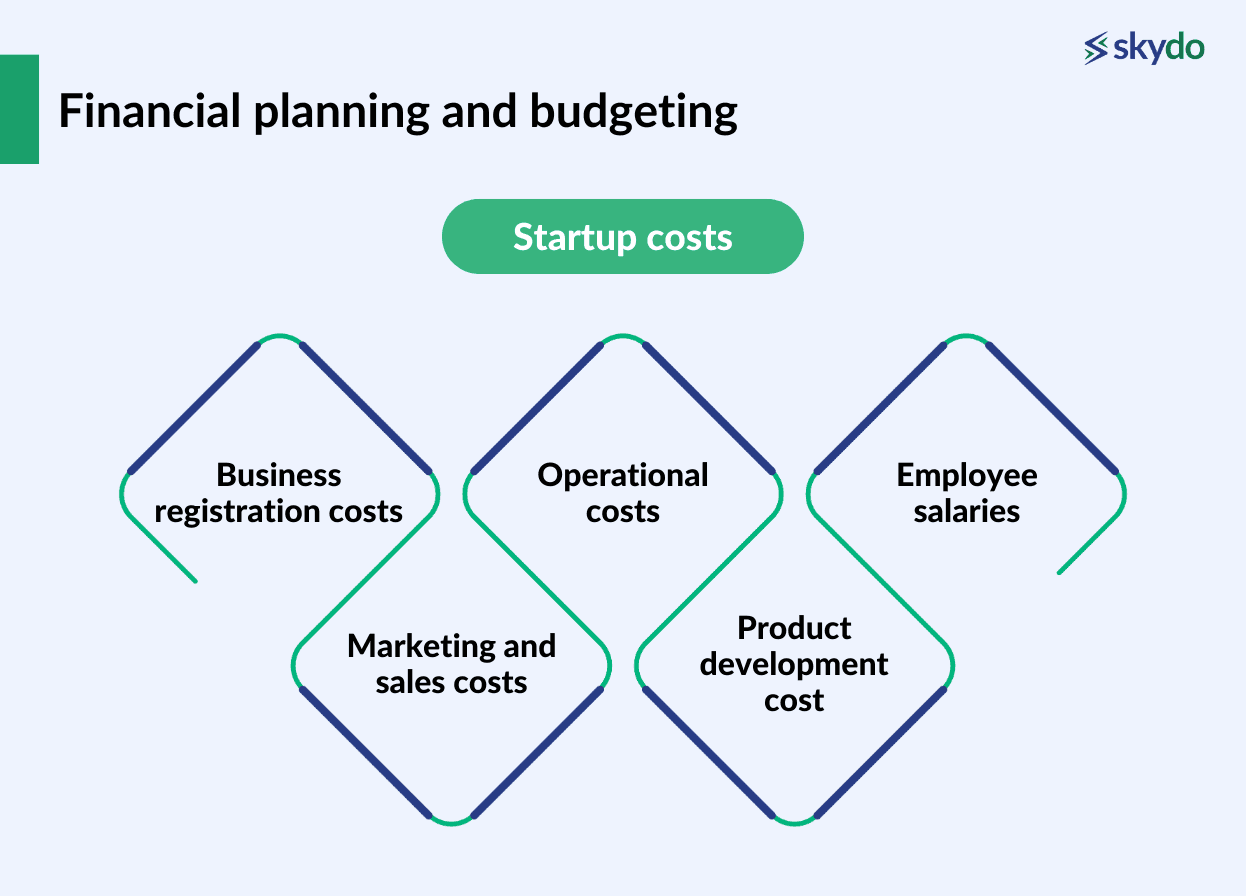
- Business registration costs
- Operational costs
- Employee salaries
- Marketing and sales costs
- Product development cost
2. Funding options
When you set up a business after gaining significant freelancing experience, you can bootstrap your business initially or get seed funding from peers or relatives.
Prepare a detailed budget and allocate resources effectively for different purposes. It requires creating a cash flow projection, controlling expenses, and creating contingency funds.
#5: Branding and Marketing
Intense competition in the market has made branding non-negotiable. It boosts online visibility, brand awareness and brand recognition. Here’s how you can get started with branding and marketing.
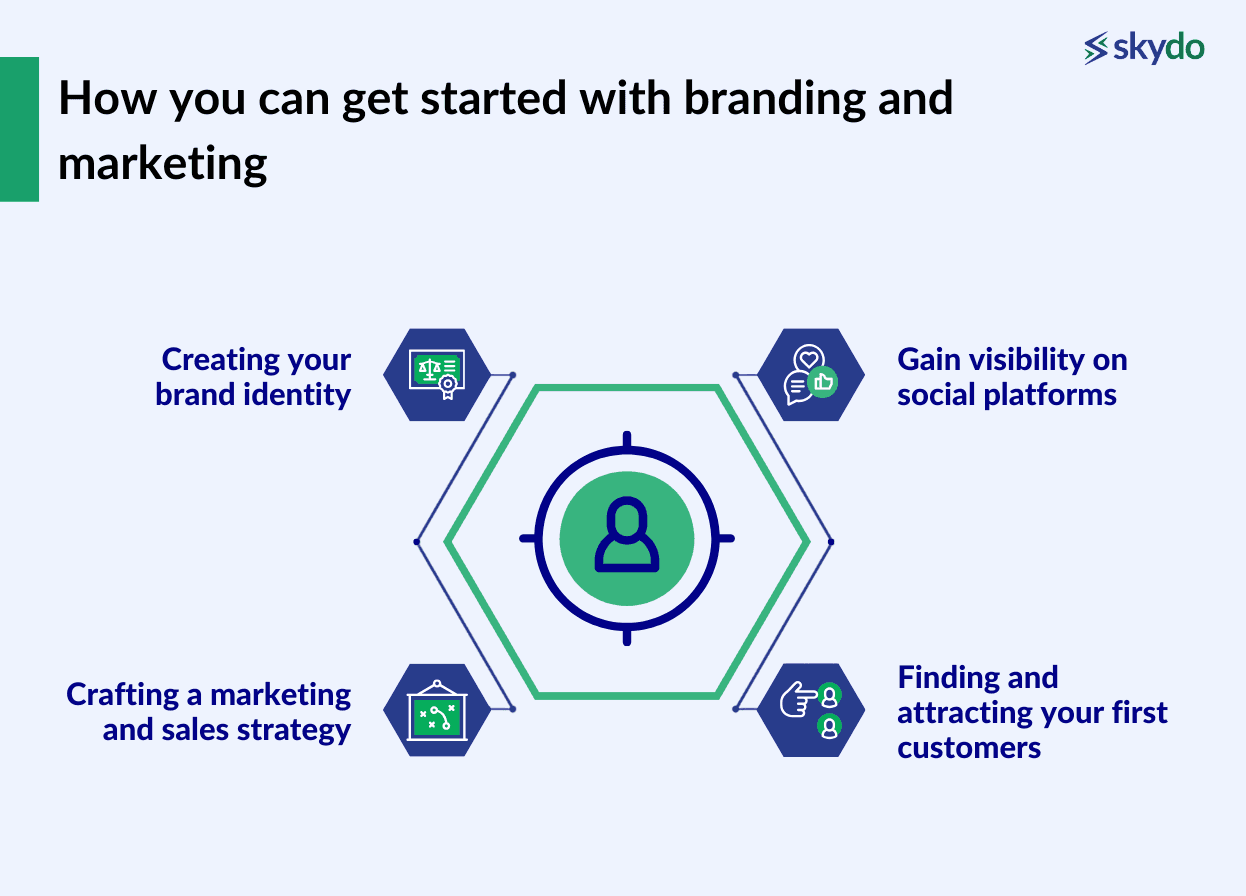
- Creating your brand identity
The first step is to create a unique brand identity by defining core brand values and messaging guidelines. Ensure that they are consistent across various social media platforms. You need to also use a compelling brand design template for logos, brand images and social media graphics.
- Gain visibility on social platforms
You can gain online visibility in a few months by consistently posting and engaging with your target audience on social media platforms.
- Crafting a marketing and sales strategy
Instead of focusing on several marketing channels at once, use social media marketing initially. Other effective marketing strategies are email marketing and content marketing. However, primarily, you should set specific, measurable, achievable, relevant, and time-bound (SMART) marketing goals.
- Finding and attracting your first customers
You can focus on lead generation strategies to get inbound and outbound leads. Cold outreach is one of the best ways to acquire clients. Read here to know how you can do it.
#6: Scaling and Growth
This step requires a thorough target market analysis, strategic planning and effective implementation. The following are some actions that can help scale your business.
1. Managing growth challenges
The common challenges that act as a growth barrier are operational efficiency, cash flow management, low customer retention rate, market saturation, and high customer acquisition costs.
Here are some ways to overcome these challenges:

- Conduct in-depth market research to find opportunities, areas for growth
- Build a unique selling point to scale your business
- Invest in the latest technology and tools for competitive advantage
- Ensure excellent customer service and use customer relationship management (CRM) tools like Salesforce, HubSpot, and ClickUp
2. Hiring and building a team
One of the best ways to scale a business is to hire professionals with a diverse skill set and build an efficient team. It helps manage different operations of a business. It also gives you time to focus on business expansion, lead generation, or other core business activities.
3. Diversifying your offerings
Adding new products or services to your business portfolio allows you to cater to a large customer base. It expands your customer base and can improve revenue. To mitigate risks, you can run pilot programs initially to check customer response to your new product or service.
4. Expanding your market reach
One of the best ways to scale your business is to reach out to foreign clients and take your business global. It increases revenue and reduces financial risk.
#Bonus: Resources and Support
Entrepreneurship is considered a lonely journey. You have to often make decisions without any support or guidance and ensure steady growth in a competitive business environment. It creates a lot of pressure, especially at the beginning of an entrepreneurial journey, when you move from a freelancer to a business owner role.
However, here are a few ways to make the journey smooth and more fruitful.
1. Utilising business support networks
Decision-making is one of the toughest aspects of running a business. You can't manage all things alone and need support or guidance to make decisions and navigate through complexities. Hence, you should build a support network.
You can join online communities on Slack, LinkedIn, WhatsApp, or other apps to connect with other entrepreneurs and freelancers, people who have been in your shoes. Connect with other professionals or entrepreneurs on LinkedIn. You can ask questions on forums and find solutions through peer support.,
2. Seeking mentorship and guidance
Running a business means encountering several challenges, some of which you won't be able to tackle yourself. Hence, you should seek mentorship and guidance.
You can reach out to your previous colleagues for guidance or other experienced professionals in your network. Another way to seek guidance is cold outreach through LinkedIn or emails. Networking events and entrepreneurial/business meetups are the best places to find mentors.
3. Online resources and tools
The following are some popular tools to automate business processes and improve efficiency:
- HubSpot growth platform for marketing, sales, and lead generation
- Skydo for sending invoices, receiving payments
- Squarespace for website design and creation
- Asana for project management
- Dropbox for sharing files
Conclusion
At some point in their career, nearly all freelancers encounter the dilemma of whether they should grow their freelancing careers or set up a business. Taking the leap from freelancer to business owner can significantly help you expand your business.
Even though the entrepreneurial journey has its ups and downs and involves several responsibilities, it offers significant benefits. Skydo makes this journey easier by sorting the financial management part.
FAQs
Q1. When is the right time to move from a freelancer to a business owner role?
Ans: Every entrepreneur has a different journey. There is no ideal time to start a business. However, you must consider certain factors such as financial stability, consistent workflow, established client base, entrepreneurial mindset, and risk appetite before setting up a business.
Q2. How is running a business different from freelancing experience?
Ans: Running a business is similar to being a freelancer. You have to find clients and deliver projects. However, a business operates on a large scale. As a business owner, you focus on getting bigger clients.
Survival risk is low in freelancing experience but businesses face high survival risk. However, businesses are more sustainable in the long run and experience significant growth because of teamwork.
Q3. What are the most common challenges freelancers encounter in scaling a business?
Ans: Building and nurturing a team, financial management, declining sales, and low customer retention rates are some of the common challenges freelancers with an entrepreneurial mindset face while scaling their business.









